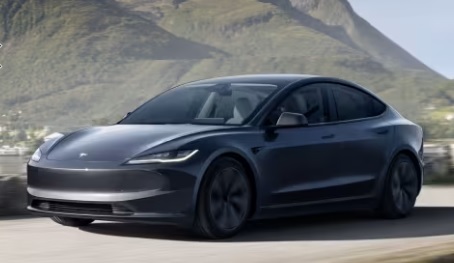Key specs
Tesla Model 3 (Sedan) Model 3 (facelift 2023) 2023,2024,2025
What is the body type, Tesla Model 3 (facelift 2023) Long Range 82 kWh (498 Hp) Dual Motor AWD 2023?
Sedan, Fastback, 4 Doors, 5 Seats
How fast is the car, Tesla Model 3 (facelift 2023) Long Range 82 kWh (498 Hp) Dual Motor AWD 2023?
201 km/h 124.9 mph
How many cylinders, Tesla Model 3 (facelift 2023) Long Range 82 kWh (498 Hp) Dual Motor AWD 2023?
Electric,
What is the drivetrain, Tesla Model 3 (facelift 2023) Long Range 82 kWh (498 Hp) Dual Motor AWD 2023?
All wheel drive (4x4),
How long is this vehicle, Tesla Model 3 (facelift 2023) Long Range 82 kWh (498 Hp) Dual Motor AWD 2023?
4720 mm
185.83 in.
How wide is the vehicle, Tesla Model 3 (facelift 2023) Long Range 82 kWh (498 Hp) Dual Motor AWD 2023?
1850 mm
72.83 in.
What is the curb weight, Tesla Model 3 (facelift 2023) Long Range 82 kWh (498 Hp) Dual Motor AWD 2023?
1828 kg
4030.05 lbs.
Tesla Model 3 (Sedan) Model 3 (facelift 2023) 2023,2024,2025 Specs
General information
| Brand |
Tesla |
| Model |
Model 3 (Sedan) |
| Version |
Model 3 (facelift 2023) |
| Engine version |
Long Range 82 kWh (498 Hp) Dual Motor AWD |
| Year production start |
2023 |
| Vehicle type |
Sedan, Fastback |
| Acceleration 0 - 100 kmh sec |
4.4 sec |
| Curb weight kg -lbs total |
1828 kg
4030.05 lbs.
|
| Overall length mm - inch |
4720 mm
185.83 in.
|
| Doors |
4 |
| Top Speed |
201 km/h 124.9 mph |
Engine specs
| Cylinders |
Electric |
| Weight / horsepower kg/hp - hp/tons |
3.7 kg/Hp
272.4 Hp/tonne
|
| Weight / torque kg/Nm - Nm/tons |
3.3 kg/Nm, 306.3 Nm/tonne
3.3 kg/Nm
306.3 Nm/tonne
|
| Fuel type |
Electricity |
| Powertrain architecture |
BEV (Electric Vehicle) |
| Electric motor power |
283 Hp
|
| Electric motor torque |
420 Nm 309.78 lb.-ft.
|
| Total available power |
498 Hp
|
| Totale available torque |
560 Nm 413.03 lb.-ft.
|
| Eng 56 |
Battery -82 kWh
|
| Eng 57 |
Electric unit layout - Rear axle, Transverse
|
Transmission and Drive system
| Drive configuration |
All wheel drive (4x4)
|
Brakes
| Front brakes |
Ventilated discs, 320x25 mm |
| Rear brakes |
Ventilated discs, 335x20 mm |
| Anti-lock brake system |
ABS (Anti-lock braking system) |
Steering
| Steering type |
Steering rack and pinion |
| Turning diameter m - ft |
11.7 m
38.39 ft.
|
Suspension
| Front suspension |
Coil spring, Double wishbone, Transverse stabilizer |
| Rear suspension |
Independent multi-link suspension, Coil spring |
Wheels & Tyres
| Wheels size |
235/45 R18; 235/40 R19
|
| Wheels rims |
8.5J x 18; 8.5J x 19 |
Passenger
| Passengers seats |
5 |
| Trunk space min liter | cu. Ft. |
594 l
20.98 cu. ft.
|
Dimensions
| Overall length mm - inch |
4720 mm
185.83 in.
|
| Overall width mm -inch |
1850 mm
72.83 in.
|
| Overall height mm -inch |
1441 mm
56.73 in.
|
| Wheelbase mm - inch |
2875 mm
113.19 in.
|
| Track width front mm - inch |
1584 mm
62.36 in.
|
| Track width rear mm - inch |
1584 mm
62.36 in.
|
| Coefficient of drag |
0.219
|
Weights
| Curb weight kg -lbs total |
1828 kg
4030.05 lbs.
|
| Gross weight kg -lbs total |
2232 kg
4920.72 lbs.
|
| Capacities kg - lbs |
404 kg
890.67 lbs.
|
Fuel economy
| Fuel economy-190 |
Autonomy WLTP 629 km 390.84 mi |
Engine type
Electric
https://www.thecarspec.com/components/engine/electric

